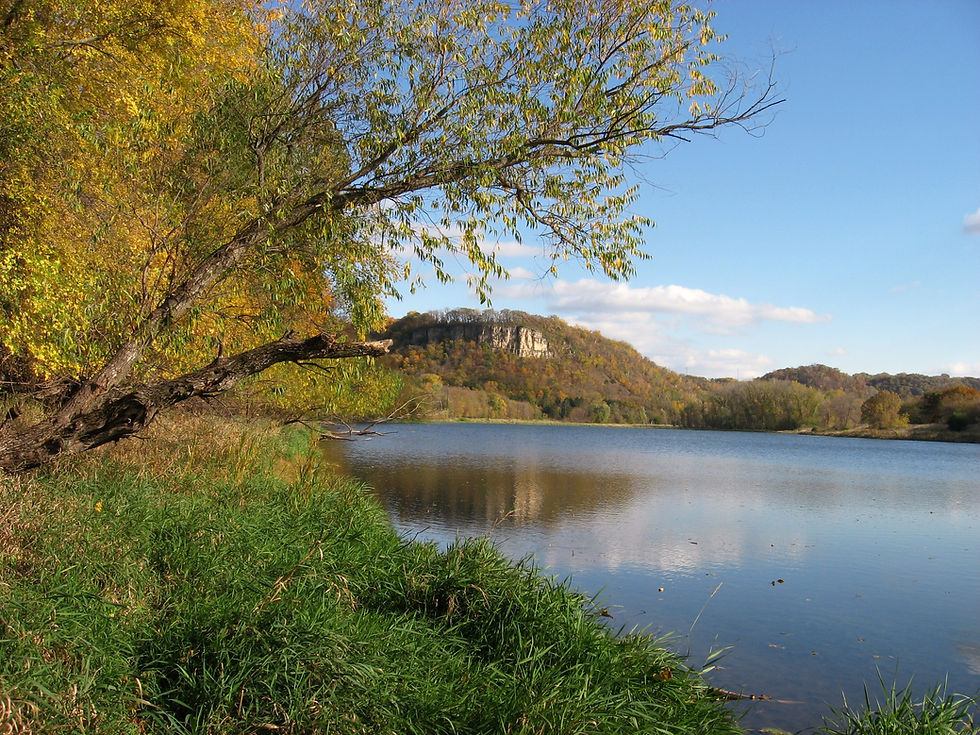"July Is Performing Its Magic"
- wacoutanaturenotes
- Jul 28
- 3 min read

I was recently informed by Jake Gaster, Frontenac State Park Manager, that on July 1st roughly 35 goats were brought back to the park to perform their buckthorn removal duties. This endeavor takes place on 45 acres of park property on the south side of Rattlesnake Bluff.
The overall goal of the project is to restore the goat prairie habitat that has been compromised in recent years by the invasive buckthorn. The area in question is fenced off by electric fencing powered by a solar collector.

As of July 27th, all indications are the legendary goat has no desire to socialize with the new team of buckthorn removal experts.
While having dinner on July 12th, Kathy and I observed "White Lightning" walking back and forth out at the tip of Rattlesnake Bluff.

As I prepared to launch my canoe in the early morning of July 6th, I encountered the leftovers of an impressive mayfly hatch from the previous evening. In addition to the flying insects, the surface of the river was alive with fish surfacing to take advantage of all the available food.

Adult mayflies have a very short lifespan. They spend most of their lives in the sediment at the bottom of the river emerging, reproducing and dying in a day or two. An impressive mayfly hatch like we recently experienced is an indication of a healthier river. Historically, Red Wing has experienced several large hatching events resulting in snowplows having to clean off the bridge crossing the river.
The same cannot be said for the river above Lock and Dam #2 above Hastings. It wasn't until 1987 following a 30 year period of massive pollution from the Twin Cities that mayflies started to make a comeback on this section of river.
In the summer of 1964, I was hired as a fisheries biologist aide for the DNR to work on the Mississippi River from Winona to the confluence of the Minnesota River. Our job was to sample fish populations at established locations along the river. Suffice it to say, above Hastings our trap nets yielded few if any fish and a plethora of garbage and sewage. No mayflies were observed. It was a memorable and stomach churning experience.

A common topic of conversation this summer among folks in our neighborhood is "I just can't believe all the rabbits. They are everywhere, day and night."
There are a combination of factors leading to this overpopulation. Two winters of little snow and a lack of severe temperatures, favorable breeding conditions and plenty of food are responsible for this population boom. Not to mention rabbits usually have two litters a year.
The fox and coyotes must be overwhelmed.

During the early weeks of the summer, numerous large flocks of white pelicans were frequently observed at various locations near the Head of Lake Pepin. With significant rain events in June and July, the river has risen 3 to 4 feet.
Higher water levels create difficult feeding challenges for these birds. I have not observed pelicans on the river in the past few weeks. Chris Perkins, local river enthusiast, has informed me many of these pelicans are now being observed in the shallower backwaters of the nearby Vermillion River.

The number of hummingbirds attracted to our feeders this summer is definitely lower than previous years. Until July 17th, we were only observing one male and one female.
Then on the 17th, a total of 5 birds were showing up at one time. This indicated three young nestlings had fledged the nest. As we get closer to the fall, those numbers will rise substantially as migrating hummers will stop and refuel for their long journey south.

During the month of July, the Wacouta Prairie has come alive with numerous new colorful forbs. This is even true for the section of the prairie that experienced a prescribed fire. One of the most abundant and colorful plants is the prairie coneflower.

By far the most noticeable prairie plants is the wild bergamot. These plants have aromatic leaves frequently used to make mint tea.




Great photos and nature notes for July. Thank you for sharing, Bruce! I've been thinking there should be some pretty plump fox and coyote with all the bunnies hopping about. What about owls, eagles, hawks, etc.? Would they be helping to control the bunny population?
We keep enjoying your blogs! AND, we learn a lot from them/you.
Thanks again, Bruce for your lively and informative blog. Fun to know White Lightning is still roaming around!
Again a wonderful post with details, thanks for keeping us informed.!
Thank you for another informative blog!